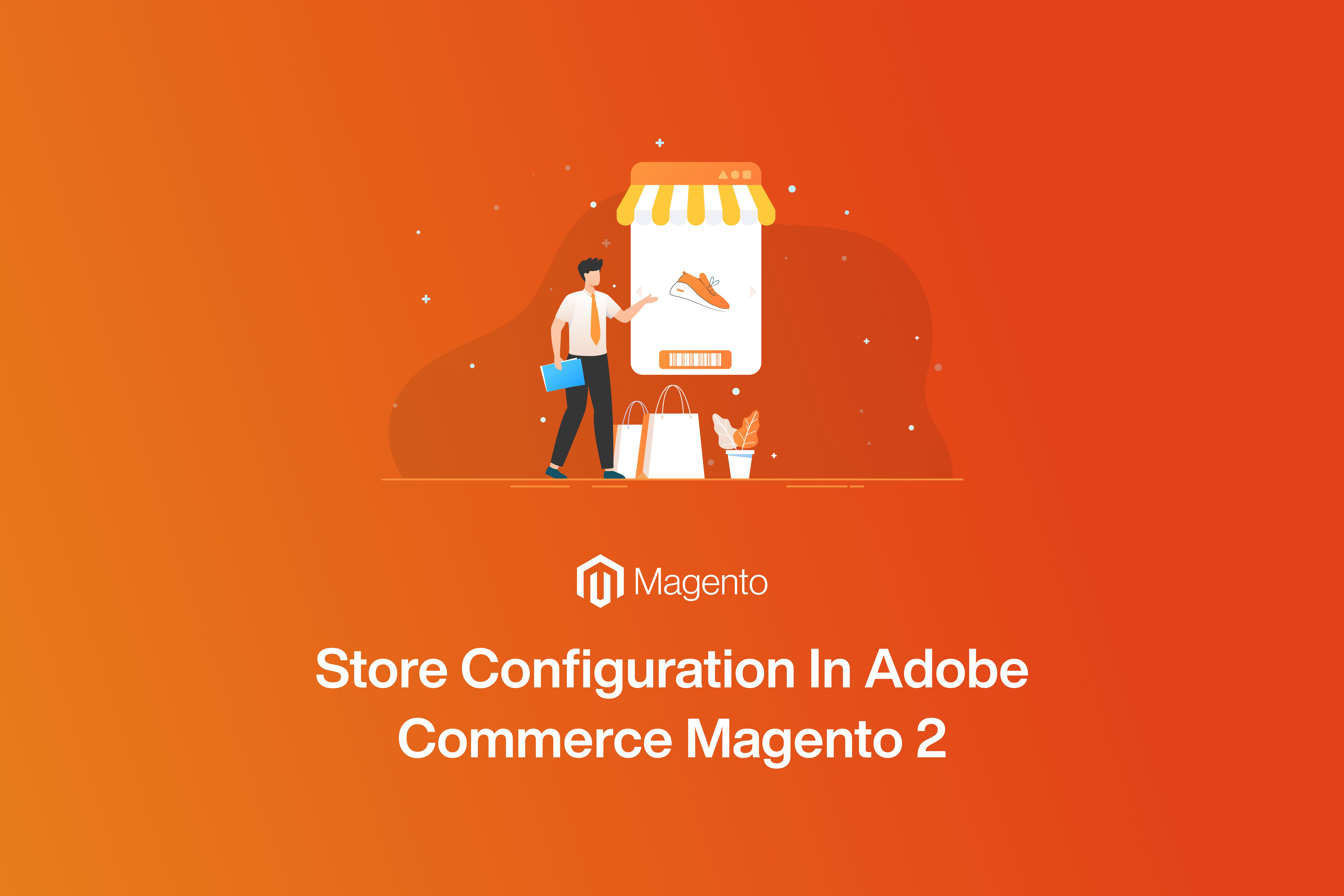Adobe Commerce configuration refers to the settings and options that control the behaviour and appearance of the store. These settings can be found in the Magento Admin Panel, under the "Stores" menu, where you can configure various aspects of the store, such as the general settings, payment methods, shipping methods, taxes, email templates and more. Let's break down some key aspects of store configuration in Magento 2
1. Store Information
Configure the store name, contact details, time zone, and store view. This is usually done when you first set up your store. In Magento 2, you have the flexibility to create multiple store views, allowing you to serve different languages or regions seamlessly. Each store view can have its own unique design, product catalog, and language settings. This feature is incredibly valuable if you're targeting a global audience, as it enables you to tailor the shopping experience to each specific market.
2. General Configuration
The general configuration section encompasses a wide range of settings that influence how your store operates. Here are some key settings to consider:
Base Currency: Choose the primary currency for your store. This is essential for accurately pricing your products and handling international transactions.
Time Zone: Set your store's time zone to ensure that timestamps for orders, product availability and promotions are accurate.
Default Page Layout: Decide on the default page layout for your store. You can choose between one-column, two-column, or three-column layouts, depending on your design preferences.
Guest Checkout: Enabling guest checkout can simplify the buying process for first-time customers, but you should also offer the option for customers to create accounts for easier order tracking and future purchases.
Newsletter Subscriptions: Allow customers to subscribe to newsletters to stay informed about promotions, new products, and updates.
Reviews: Enable or disable product reviews and ratings to gather feedback from customers and build trust.
3. Design Configuration
Your store's design is crucial for attracting and retaining customers. Magento 2 provides a robust theming system, allowing you to choose and customize themes to match your brand's identity. Here are some design-related considerations:
Theme Customization: Customize the theme's appearance, including fonts, colors, and layout. Magento 2 offers extensive customization options through its admin panel and allows for custom CSS modifications.
Responsive Design: Ensure your chosen theme is responsive, meaning it adapts to different screen sizes and devices. A mobile-friendly design is essential for a seamless shopping experience on smartphones and tablets.
Page Builder: Magento 2's Page Builder tool empowers you to create and edit content pages with a drag-and-drop interface, making it easier to build engaging landing pages and product descriptions.
4. Payment Methods
Configuring payment gateways is crucial for enabling customers to make purchases. Magento 2 supports a wide range of payment methods, and you can configure them based on your business needs:
Credit Cards: Integrate popular payment processors like Stripe, Braintree, or Authorize.net for accepting credit card payments.
PayPal: Set up PayPal as a payment option, allowing customers to pay securely using their PayPal accounts.
Offline Payments: Offer offline payment methods such as bank transfers, cash on delivery, or purchase orders to accommodate various customer preferences.
Payment Processors: Ensure that your payment processors are properly configured and tested to prevent payment processing issues.
5. Shipping Methods
Smooth order fulfilment is vital for customer satisfaction. Magento 2 provides several shipping configuration options:
Flat Rate: Set a fixed shipping fee for all orders, suitable for businesses with simple shipping needs.
Table Rate: Configure shipping rates based on factors like destination, weight, and quantity of items in the cart, allowing for more precise shipping cost calculations.
Carrier-Specific Shipping: Integrate with popular carriers like UPS, FedEx and DHL for real-time shipping rate calculations and label generation.
Free Shipping: Offer free shipping based on specific conditions, such as a minimum order amount or specific product categories.
Shipping Rules: Implement custom shipping rules to handle complex scenarios, such as drop shipping or multi-warehouse operations.
6. Tax Configuration
Handling taxes correctly is crucial for e-commerce compliance. Magento 2's tax configuration options are versatile:
Tax Rules: Create tax rules to define how taxes are calculated based on factors like product type, customer location and tax classes.
Tax Rates: Set up tax rates for different regions, taking into account local tax laws and regulations.
Product Tax Classes: Assign tax classes to products to specify which items are subject to taxation and at what rate.
Customer Tax Classes: Define customer tax classes to categorize customers for tax calculation purposes.
Magento 2 provides a powerful tax calculation engine that can handle complex scenarios, ensuring that your store complies with local tax laws and provides accurate tax calculations to customers.
7. Catalog Configuration
A well-organized product catalog is essential for driving sales. Magento 2 offers numerous catalog configuration options:
Product Attributes: Create custom product attributes to categorize and describe your products effectively. These attributes can be used for filtering, sorting, and searching.
Attribute Sets: Organize your product attributes into attribute sets to simplify product creation and management.
Product Search: Configure search options, such as enabling full-text search or using Elasticsearch for faster and more accurate search results.
Categories: Create and manage product categories to organize your catalog logically. Use category pages to showcase products within specific categories.
Product Listings: Configure product listing settings, such as the number of products per page and sorting options.
8. Customer Configuration
Serving your customers effectively is a top priority. Magento 2's customer configuration settings allow you to manage customer accounts and interactions:
Customer Registration: Specify whether customers can create accounts during checkout and set up customer approval processes if needed.
Customer Groups: Create customer groups and set group-specific pricing, discounts, and promotions.
Address Configuration: Define address format and validation rules to ensure accurate customer data collection.
Account Dashboard: Customize the customer account dashboard to provide a personalized experience for registered users.
9. Security Configuration
Protecting your store and customer data is paramount. Magento 2 offers security configuration options:
HTTPS: Enable HTTPS for secure data transmission and build trust with customers.
CAPTCHA: Implement CAPTCHA on forms and login pages to prevent spam and automated attacks.
Security Headers: Configure security headers, such as Content Security Policy (CSP) and X-Content-Type-Options, to enhance your store's security posture.
10. Extensions and Modules
Magento 2 has a vibrant ecosystem of extensions and modules that can extend your store's functionality. When configuring these, consider the following:
Compatibility: Ensure that the extensions and modules you install are compatible with your version of Magento 2.
Updates: Keep extensions and modules up to date to benefit from new features, bug fixes and security patches.
Configuration: Configure these extensions through the admin panel to tailor their functionality to your specific needs.
How to create system.xml configuration
To further enhance your catalog configuration, you can customize the settings in your system.xml file. This file is a crucial part of your store's configuration and allows you to define custom settings for your catalog and other areas of your store. To learn more about how to create and configure the system.xml file in Magento 2, you can refer to this helpful resource here.
By leveraging the capabilities of the system.xml file, you can extend your catalog configuration options and tailor them to suit your specific business needs.
In conclusion, using system.xml in Magento makes system configuration and modification simple. You can make sure that your customers have a simple and intuitive shopping experience by setting up the store settings appropriately. It improves the flexibility and scalability of a Magento store and offers a systematic and standardized manner for controlling system options. System.xml is a crucial tool for developers and administrators in Magento since it makes changing system configurations easier.




